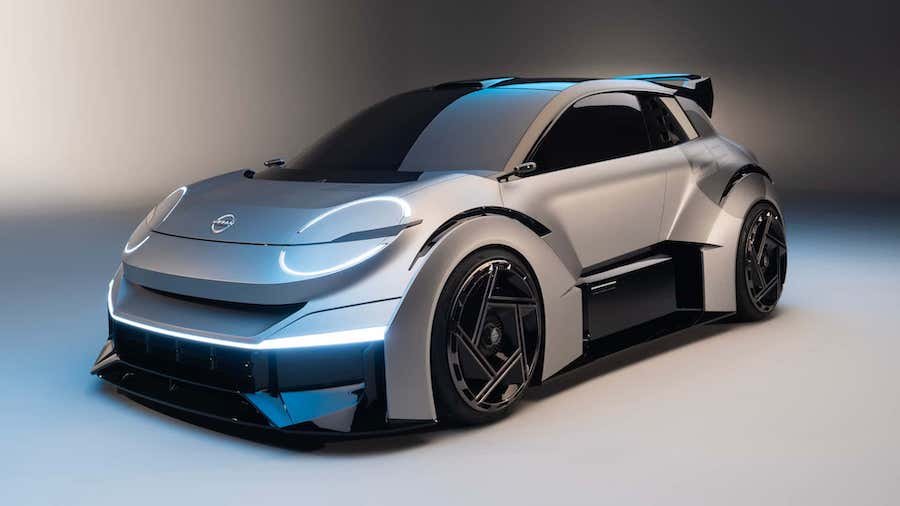Hot urban EV concept previews all-new Nissan Micra

Nissan has previewed the long-awaited next Micra with the motorsport-themed 20-23 hot hatch concept.
Created ostensibly to celebrate the 20th anniversary of the car maker’s European design centre in Paddington, London, the striking supermini bears the influence of both Nissan’s participation in the Formula E race series and the firm’s “heritage of bold hatchbacks”.
The concept was unveiled by company president and CEO Makoto Uchida in front of Nissan Design Europe’s (NDE) headquarters, with the central London venue chosen to emphasise the 20-23’s billing as a “sporty urban” proposition.
The NDE team’s brief was to design a car “with no constraints”, which they would like to drive “on the streets of the city where they work”. The result is an overtly race-inspired design that takes the lead from full-blown race cars by adopting huge diffusers at the front and rear, a touring car-spec rear wing, outsized wheel arches and ultra-low-profile racing tyres.
Other highly conceptual styling cues include the roof scoop, racing numbers, Lamborghini-style scissor doors and air-channelling louvres in the tops of the wings – all features that the manufacturer says continue “a long Nissan tradition of bringing eye-catching playfulness to the world of hatchbacks and city cars”.
Beneath the racy facade, the 20-23 gives the best look yet at Nissan’s electric replacement for the Micra, due to enter production in 2026 atop the CMF-BEV platform that Alliance partner Renault is using for its own 5 supermini and Alpine A290 hot hatchback.
The Micra’s replacement was previewed early last year as a squat, compact five-door supermini with a similar silhouette to that of its retro-inspired Renault relation, but with a raft of distinctive design cues that are expected to be shared with other EV models in the Nissan line-up.
Some of the cues visible in that initial side profile image, including the two-piece circular LED light clusters and black ‘floating’ roof, are carried over to the concept. The two cars share a similar silhouette and proportions, despite the 20-23 concept forgoing the production car’s rear doors.
The interior of the concept is far less obviously related to anything that will reach showrooms, being designed as a “futuristic interpretation of a racing car’s bare functionality”.
The driver and passenger must climb over foam-covered brace bars to access their deep bucket seats and, in place of a steering wheel, the driver grips a yoke-style device hosting an array of switches and buttons, with paddles located behind it to adjust the performance of the electric motors and regenerative brakes.
The spartan cabin, complete with fire extinguisher, exposed metalwork and “just a couple of screens for vital information”, says Nissan, is expected to evolve into a more spacious and comfort-focused set-up for the final production car, but a slew of recent Nissan concepts (as well as the Ariya SUV) major on minimalism inside, so it is likely that the Micra’s replacement will follow suit.
Nissan has given few details of its smallest electric car (not least its name, which may not be Micra), but being based on the CMF-BEV platform means it will have a multi-link rear axle and a series of lightweighting measures including a battery pack split into four space-efficient modules and EV motors that include the power converter and power-management box.
The model will be built alongside the Renault 5 at the French car maker’s ElectriCity production hub in northern France, no doubt using the same 134bhp front-mounted motor and offering the same 250-mile range as its sibling. It will also target the same price point of around £20,000.
Intriguingly, the sporting focus of the 20-23 concept suggests there is potential for a performance version of Nissan’s supermini, much as the Alpine A290 will serve as the hot sibling of the Renault 5. Nissan has already spoken of its intention to resurrect the dormant Nismo performance brand for the electric age, likely spearheaded by a sporting version of the Ariya crossover.
A similarly conceived version of the Micra replacement would slot neatly into an expanding segment of electric hot hatches, rivalling the likes of the Volkswagen ID 2 GTI, Mini Cooper SE and Abarth 500e.
Nissan has not said whether the design of the production-spec Micra replacement will be handled by the NDE team, which is led by Autocar Design Hero award winner Matthew Weaver.
The unit has been responsible for creating the huge-selling Juke and Qashqai crossovers as well as a series of radical concepts previewing the Japanese brand’s future (see right).
Speaking on the 20th anniversary of NDE’s establishment, Weaver said: “We’re a relatively small team but I look back with pride at the consistently bold, refreshing and innovative work we produce – and have done since the doors first opened here 20 years ago.
“At the heart of NDE’s culture is a warm, collaborative environment where we all strive to bring outstanding design and creativity to the experience of discovering, buying and driving for our customers. It’s our job to make them fall in love with a Nissan.”



Related News


